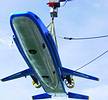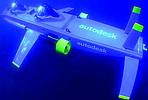Inventor software brings underwater flight a step closer to reality
April 2003
Sub-sea flight came a step closer to reality recently with the maiden voyage of a two seat exploration craft purpose-built to fly underwater.
The winged submersible - Deep Flight Aviator - was built specifically for long-range, economical ocean exploration and to fully explore the pioneering concept of sub-sea flight. The craft, which was built by Hawkes Ocean Technologies (HOT), made its historic maiden voyage in San Francisco Bay. The vessel was designed using Autodesk Inventor, software for 3D mechanical design, enabling a team of two engineers to design and build the vehicle at a fraction of the cost of typical ocean technology projects.

Courtesy of Amos Nachoum Photography
The Deep Flight programme began in the 1980s with the aim of moving beyond existing constraints and developing a new generation of lightweight, manned, microsubmersibles that could open deep blue ocean space in the same way the first aircraft moved beyond ballooning to open air space.
Previously submersible craft all used variable weight and or displacement, such as ballast, buoyancy tanks, and drop weights, to change their apparent weight in water, causing the craft to either sink or become buoyant and rise to the surface. Variable buoyancy (VB) was a fundamental characteristic of the bathyscaphe, submersibles, and submarines.
In contrast, Deep Flight Aviator has no VB systems. It moves vertically through the water under power, using forces developed on its wing surfaces similar to the way in which an aircraft does. Graham Hawkes founded HOT when he realised that underwater flight was necessary for deep-sea exploration. He began experimenting with ways to improve a submersible's hydrodynamic efficiency and used Autodesk software to design wings for Deep Flight vessels.

Aviator Under Water:
Courtesy of Hawkes Ocean Technologies
"The Deep Flight Aviator is as different from all previous submersibles as aircraft are to balloons. While conventional submersibles are slow, bulky, stiff underwater balloons, the Deep Flight Aviator is a lightweight, high-powered, composite airframe with wings, thrusters and flight controls similar in configuration to the USAF A10," explains Hawkes.
"Just as design advancements in air flight have allowed us to explore space, Deep Flight's unique design enables economical, long-range search and survey work, and should prove to be a revolutionary tool for ocean science and exploration." The goal of the Deep Flight project is to make (manned) ocean exploration accessible. An equally important goal is to excite the next generation about the importance of exploring the 75% of the planet that is covered by water. Right now, it is estimated that less then 5% of aquatic space has been explored because only a handful of ageing submersibles explore our waters worldwide.
"We are delighted to be lead technology partner on the Deep Flight Aviator project," says Errol Ashwell, Autodesk Africa's managing director. "Our customers are some of the most creative people in the world and we understand the need to support inventiveness in order to remain competitive."
Hawkes explains that with Autodesk Inventor, HOT's products can be created and tested before any metal is cut, minimising the design cycle time and allowing the company to explore a wider range of concepts. "Autodesk Inventor gives us the ability to model complete assemblies, allowing us to effectively check for problems before going into production. This capability has decreased our design errors immensely and has enabled us to design and build our submersibles with a skeleton crew, at minimal costs. Productivity has increased 400% allowing us to do the same work with two engineers that used to require eight."
The Deep Flight Aviator was designed and built by HOT in partnership with Autodesk. Sony Electronics added its video technology to the Deep Flight Aviator, by supplying advanced digital video cameras, the DCR-VX2000 and the DCR-PC101, for the project. Pelican Products, a leading manufacturer of waterproof, rugged equipment cases and flashlights is also a product partner. Spirit Of Adventure, a corporation created to push the limits of underwater technology and expand the frontiers for exploration and adventure, owns the first Deep Flight Aviator craft.
For more information contact Autodesk, 012 664 8115.
Others who read this also read these articles
The high-end MCAD and cPDm market segments of the PLM strategy
CIMdata considers the high-end MCAD market to include only those few CAD solution providers that deliver very comprehensive computer-aided design and analysis capabilities that are also tightly integrated with an enterprise-capable cPDm solution from the same supplier[ December 2005 ]
SA's prototype designers awarded
The SABS Design Institute is the driving force behind design promotion in the country through various award schemes, supporting innovation and entrepreneurship[ October 2005 ]
2D to 3D: the path to better products, faster and cheaper
Modern 3D CAD systems allow designers and engineers to edit a few parameters and automatically create the downstream deliverables for unique variants in minutes, instead of days or weeks[ October 2005 ]
ECL in Africa
ECL ensures a worldwide coverage of its client base through local service units which incorporate all the ECL know-how[ August 2005 ]
Catia brings business to South Africa
The fact that the A400M contracts were awarded to local enterprises is a strategic breakthrough for the South African aerospace industry[ August 2005 ]
Strand7 analyses the Beijing Water Cube
The latest Strand7 Release 2.3 has added the capability to take site specific seismic time histories and simply create equivalent spectral curves[ June 2005 ]
Pro/E versus SolidWorks
In summary, SolidWorks' swept surfaces and solids are more limited in their capabilities than Pro/Engineer's[ June 2005 ]
Northern Railway Extension receives green light
Windhoek Consulting Engineers was appointed as consulting engineers for the Northern Railway Extension, responsible for all aspects regarding the design and construction supervision of the total project valued at N$ 1,4 billion[ April 2005 ]
Others who read this also read these news items
Digitising a standard racing engine provides a springboard for future improvements
[ December 2005 ]
Nelson Mandela Metropolitan University leads the way with Catia V5
[ December 2005 ]
Integrated CNC solution for SA tooling industry
[ December 2005 ]
Accelerated design at Donkin Fans
[ December 2005 ]
PGF transforms its vision into reality
[ December 2005 ]
Defy introduces new product range
[ October 2005 ]
New Smarts for legal eagles
[ October 2005, Cadshop ]
Vectorworks scores with architects on ease of use
[ October 2005 ]
Others who read this also read these regulars
Search Site
Subscribe
Previous Issues
Other Technews Publications
Other Technews Buyers Guides
 |  | Copyright c1995-2009 Technews Publishing (Pty) Ltd.. All rights reserved. |